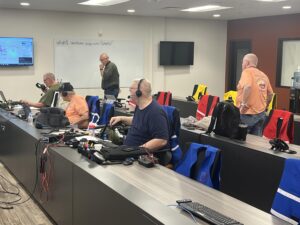Reprinted with permission from the ARRL
| Utah ARES Conducts Statewide Simulated Emergency Test (SET) |
| On November 2, 2024, Utah ARES ran its first statewide Simulated Emergency Test (SET) in cooperation with three adjoining states. The exercise was done in partnership with a large hospital organization with critical operations across Utah and other states. The exercise was focused on the use of AREDN (Amateur Radio Emergency Data Network) mesh network connectivity and message handling capabilities. Voice and digital modes were used on HF. Starlink was also tested as a way to connect isolated AREDN networks.
Background Utah ARES had previously agreed that the hospital organization would be a served agency, and this exercise was a natural extension of that agreement. County-level ARES groups in southern Utah had previously created AREDN mesh networks that had at least some coverage in five counties and were particularly strong in Washington County (with the largest population in southern Utah and a number of hospital facilities). This exercise expanded the geography to include Salt Lake County in northern Utah, home to over a third of Utah’s residents and many major hospital facilities. Design Clients at served agencies should not have to be fluent in radio operations. In order to make them most comfortable with amateur radio as a possible emergency solution, it was decided that ARES would integrate VoIP phones over mesh networks into this exercise. All prospective clients use desk phones in their command centers, and many surplus VoIP devices were available locally. Mesh networks are a relatively new technology to Utah ARES. Research needed to be done to determine best locations for mesh nodes in specific geographic areas as well as exact capabilities of mesh networks regarding VoIP communications, large-file transfers, and chat messaging protocols. Connecting mesh networks over long distances using Starlink also needed additional research to determine best practices and capabilities. This exercise was also designed to test the capabilities of individual radio operators in setting up and operating portable field stations using alternate power (battery, solar, etc.), Radio operators were required to erect an effective antenna system and connect their transceivers to alternate energy sources that were sufficient to power their individual stations for the duration of the exercise. The exercise also tested operators’ skills in message-handling in voice and data modes. Field locations for this exercise were chosen at client sites that would have a critical need for mesh capabilities in the event of a communications emergency. Rooftop access was not feasible at any of the chosen locations in Salt Lake County, so all of these locations were ground-based. Results Portable mesh nodes: The location, setup and operation of portable mesh nodes was performed with partial success. ARES operators in southern Utah have more experience with this technology and had a greater level of success. Topography and node location/elevation were issues in Salt Lake County. Integration of Starlink: Even though the Washington County Starlink terminal went down during the exercise, an operator used his personal Starlink unit to reestablish connectivity from the Washington County mesh to other mesh networks around the state. This was a successful outcome. Communication/message handling: When nodes were able to connect, communications went well. Several VoIP phone calls were completed. All of the messages via VoIP were intelligible, although some contacts were marginal. Large data files (up to 46 MB) were transferred via FileZilla. Over 19 files were transferred in total. Real-time videos were able to be viewed on the mesh network. Salt Lake, Garfield, and Washington Counties were all able to connect their respective mesh networks via Starlink. More than 50 chat messages were sent via different protocols on the mesh networks. No issues were noted when passing messages via HF Winlink using remote message servers. Over 25 messages were sent using this method. Conclusions Most participants agreed that gaining access to rooftops would be critical to deploy a reliable AREDN network in northern Utah’s challenging topography. Our partners expressed a willingness to make building rooftops available for future exercises. Additional exercises will be conducted to determine the maximum capabilities of the mesh network. Contacts: ARRL Utah Section Manager Brett Pruitt, K7BDP, Salt Lake County EC Paul Plack, AE4KR, and ARRL Utah PIC Scott Rosenbush, K7HSR.
Bob Vosper, KZ1B, Boyd Borden, K7OUF, Ric Wayman, K7DLX, and Jay Kay, K7SWU, at the Southern Utah Command Center. (Photo courtesy of ARRL Utah Section Manager Brett Pruitt, K7BDP) |


